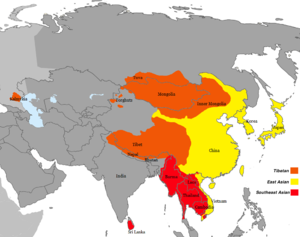Living traditions of Buddhism
Living traditions of Buddhism refers to the forms and traditions of Buddhism that developed from the original teachings, with emphasis on actual practice rather than the theories of an idealized religion.
About living traditions
Since ancient India until modern times, it has been common for traditions, groups and individuals to be influenced by more than one textual school or tradition. For example:
- Chinese pilgrims to India around 400 CE reported seeing Mahayana and non-Mahayana monks both co-existing in the same monasteries.[note 1] This seems to have been a process of self-identification, where those monks who were attracted to the Mahayana sutras identified themselves as Mahayana.
- The East Asian Buddhist tradition was influenced by the native Chinese philosophies of Taoism and Confucianism.
- The Tibetan Buddhist tradition was influenced by the indigenous traditions such as Bon.
- In many countries of Southeast Asia, local indigenous traditions influence the practice of Buddhism in those countries
- In Western countries today, many contemporary Buddhist practitioners are influenced by more than one Buddhist tradition or textual school.
Contemporary scholar Damian Keown writes:
- When Buddhism spreads it tends not to eradicate existing beliefs but to incorporate them, along with local gods and spirits, into its own cosmology. It is quite common to find Buddhists at the village level [in Southeast Asia] turning to the local gods for solutions to everyday problems – such as curing an illness or finding a marriage partner – and to Buddhism for answers to the larger questions about human destiny.[1]
Idealized religion vs. practiced religion
This distinction between the textual schools and the living traditions is expressed by contemporary scholar James C. Dobbins, as the distinction between an idealized religion (of the doctrines) and the practiced religion (the way people live).
Dobbins writes:
- This distinction between idealized religion and practiced religion is important because there is a widespread tendency to mistake the religious ideal presented in the great doctrinal treatises for the historical reality of how religion was actually practiced. This is not the case. Throughout history there has been a disjunction between idealized and practiced religion. Needless to say, idealized religion informs and shapes practiced religion, and practiced religion likewise modifies and redefines idealized religion. At any particular moment, however, there tends to be a discrepancy between the two. In such circumstances, the ideal should not be mistaken for practiced reality. Hence, when looking at religious documents one needs to be mindful of whether they are prescriptive or descriptive in nature—that is, whether they project an idealized view of religious life or present observations of its actual practice.[2]
Contemporary scholar Rupert Gethin identifies the following areas of Buddhist thought and practice that are common to all major traditions of Buddhism:[3]
- the story of the Buddha
- a textual and scriptural tradition
- the framework of the four noble truths
- the monastic and lay ways of life
- a cosmology based around karma and rebirth
- the teaching of no self and dependent arising
- a progressive path of practice leading on from good conduct and devotions through stages of meditation to a higher understanding
- the theoretical systems of either the Abhidharma or the Madyamaka and Yogācāra
- the path of the bodhisattva
Major historical traditions
There is no standard naming convention for the major historical living traditions of Buddhism. However, most contemporary Buddhist scholars identify three main traditions: [4] [note 2]
- The Southeast Asian tradition of Sri Lanka and South-East Asia, commonly referred to as 'Theravada' Buddhism. (Also referred to as 'Southern' Buddhism.) Its canonical scriptures are preserved in the Pali language.
- The East Asian tradition of China, Korea, Japan, and Vietnam, also sometimes referred to as ‘eastern’ or 'Chinese' Buddhism. Its scriptures are preserved in Chinese and its general outlook is that of the Mahayana.
- The Tibetan tradition of Tibet, Mongolia and the Himalayan region, also sometimes referred to as 'northern' or 'Tibetan cultural' Buddhism. Its scriptures are preserved in the Tibetan language. Its outlook is broadly that of the Mahayana, but its more specific orientation is that of the Vajrayana (Tantric Buddhism).
Within these major traditions, there are a variety of smaller traditions and sects.
Other traditions
- Newar Buddhism of Nepal practices a unique form of tantric Buddhism. This is the only contemporary tradition that still relies on Sanskrit texts for is practice rituals and doctrines.
See also
Notes
- ↑ See account of the monk Faxian, for example.
- ↑ Different scholars may classify the main Buddhist traditions differently. For example,
- Robinson & Johnson (1982) categorize "Buddhism Outside of India" as: "The Buddhism of Southeast Asia", "Buddhism in the Tibetan Culture Area", "East Asian Buddhism" and "Buddhism Comes West".
- Rupert Gethin (1998) identifies: Theravada (southern), East Asain, and Tibetan (northern) traditions[4]
- Southern (Theravada), eastern, and northern.[5]
- See also: Prebish & Keown, Introducing Buddhism, ebook, Journal of Buddhist Ethics, 2005, printed ed, Harper, 2006
Referencess
- ↑ Keown 2000, Kindle Locations 1311-1315.
- ↑ Dobbins 1991, p. 109.
- ↑ Gethin 1998, p. 3.
- ↑ 4.0 4.1 Gethin 1998, p. 2.
- ↑ (Harvey, 1990); (Gombrich,1984)
External links
 The World of Buddhism, StudyBuddhism
The World of Buddhism, StudyBuddhism
| This article is developed by our editors based on the sources cited. |
